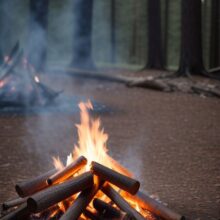The Architecture of Resilience: Building a Permanent Indoor Kitchen That Defies the Grid
The survival advice you’ve been given—the official pamphlets, the friendly blog posts, the quick checklists—they all share a critical, quiet flaw. They operate on a lie: The 72-Hour Assumption.
That three-day blackout is the safe story. It’s what we plan for when we buy a few water bottles and a canned chili stash. But for those of us who look further, who see preparedness as a life-long commitment, the real goal isn’t temporary coping. It’s transformation. It’s designing a home that can sustain life—cooking, heating, and preserving food—for six months, a year, or longer, completely free from the fragile umbilical cord of the power grid. This isn’t about emergency gear; it’s about becoming the architect of your own self-sufficiency.
The 72-Hour Mindset vs. The Six-Month Reality Check
There is a profound, almost psychological chasm between being ready for an emergency and being ready for a revolution. Most people search for simple, immediate solutions—”camping stove,” “emergency candles.” Those queries signal temporary, transactional intent.
But a select few, the dedicated minority, search for mastery: “architect a permanent indoor kitchen.” That search signals a hunger for deep, structural, expert knowledge. It’s a signal that says, “I am ready to move from a consumer of emergency products to a producer of heat and sustenance.” This is the psychological shift from panic to permanent planning.
The Subtle Difference Between Coping and Conquering
| If You’re Only Coping (72 Hours) | If You’re Conquering (6+ Months) |
| You rely on finite fuel canisters (propane). | You rely on bulk, sustainable solid fuels (wood pellets, wood logs). |
| You try to vent through an open window (risky). | You integrate dedicated architectural ventilation (a flue pipe). |
| Your goal is basic warmth and sanitation. | Your goal is cooking, baking, home heating, and long-term preservation. |
Export to Sheets
We are done with quick fixes. We are building a home ecosystem that remains unbothered when the lights go out for good.
The Safe Zone: Designing the Fireproof Heart of Your Home
When you decide to bring combustion indoors, safety ceases to be a checklist item and becomes an architectural mandate. You are mitigating the two primary risks: fire and the invisible killer, carbon monoxide (CO). The space where you cook must be a fortress of design.
Why You Need Real Fireproof Surfaces, Not Just a Tinfoil Barrier
It’s tempting to simply set a portable burner on a counter, but sustained, high-heat cooking demands a dedicated space. This requires specific materials:
- Protecting the Floor: Your permanent appliance, whether it’s a small pellet stove or a large wood burner, must sit on a non-combustible foundation—a hearth. This often means laying ceramic tile, stone, or specialized fire-rated drywall beneath the appliance. Don’t skimp here; the floor is the first line of defense.
- Protecting the Walls: Heat radiates. You must maintain the appliance’s required clearance (which can be over three feet) from any combustible wall, or, more practically, use a certified metal or masonry heat shield to safely reduce that distance.
The Architect’s Secret: Integrating Perfect Ventilation
If you only learn one thing, let it be this: Proper venting is the difference between life and death. It’s not just about letting smoke out; it’s about managing gases and air pressure.
- The Flue Pipe Protocol: For any sustained fire, you need a high-quality, double-walled stainless steel flue pipe. This is the engineered pathway that safely expels CO and other byproducts away from your living space, usually through the roof or a specially insulated wall-venting kit.
- The Makeup Air Necessity: Fire consumes oxygen aggressively. If you don’t supply a dedicated source of fresh air (a makeup air inlet) directly to the appliance, the stove will depressurize the house. The result? It sucks air, and potentially toxic fumes, back down the flue and into your kitchen.
The Ultimate Solution: Understanding the Masonry Heater
For maximum efficiency and safety, nothing rivals the Masonry Heater. This isn’t a simple stove; it’s a massive, beautiful structure of brick, stone, or concrete built around a small firebox.
The brilliance is in its function: you burn a fast, hot, clean fire for just an hour or two. The immense stone mass then stores that thermal energy and slowly, gently radiates a steady, even heat into your home for the next 20 to 24 hours. It’s the safest, most efficient, and most beautiful way to cook and heat without power, earning the ultimate stamp of authority in grid-down design.
The Micro-Fuel Ecosystem: Sustainable Heat for the Long Haul
Liquids like kerosene or white gas are too volatile, too smelly, and too finite for long-term use. A sustainable kitchen runs on solid fuels—the most reliable source when systems collapse.
Biofuel: Why Wood Pellets are the New Gold Standard
The modern, manually operated Pellet Stove—the kind that requires no electricity to feed the fire—is a game-changer.
- The Efficiency Argument: Wood pellets are essentially densified, dried sawdust. They burn hotter, cleaner, and more predictably than traditional cordwood. Their uniform size gives you precise control over your heat output, a crucial element of the mastery we seek.
- Safe Storage Advantage: Pellets are less messy, take up less space, and are far easier to store securely than a massive wood pile, removing common anxieties about pests and insects.
Managing Your Inventory: Safely Cycling Your Fuel Supply
Long-term survival hinges on being a smart logistics manager. Your fuel must be safe from moisture, which ruins its burn quality and efficiency.
- The FIFO Rule: Treat your fuel like produce: First-In, First-Out (FIFO). Use your oldest stores for supplemental heat or outdoor cooking now so your reserve is always dry and ready. This level of organization signals the high-level competence that we, as planners, strive for.
A Low-Risk Supplement: The Unsung Solar Oven
For sunny days, the Solar Oven is your ultimate low-risk companion. While it won’t cook a turkey in winter, it can easily bake bread, boil water, or slow-cook stews with zero fire risk and zero fuel expenditure. It’s the necessary, clean-energy entity that diversifies your cooking options and reinforces total safety.
Final Stage: Preservation and Water Security
The highest form of grid-down cooking is not just preparing a meal, but creating a future meal. It’s the transformation from mere consumer to self-sustaining food creator.
Achieving Mastery with Canning and Pressure Cooking
These methods require immense, sustained heat—the kind only a solid-fuel stove or masonry heater can reliably produce.
- Pressure Canning: This is the key to preserving meat and low-acid vegetables for years. Operating a large pressure canner requires a stable, wide surface and consistent heat output, tasks too difficult or dangerous for small emergency burners. When you can safely pressure-can a year’s worth of food, you have achieved true Mastery.
The Question We All Whisper: How Long Do I Really Have to Boil Water?
When the panic hits, this is the question that jumps to the front of the mind. The most valuable information is often the shortest:
The safe Boil-Time Threshold to eliminate all common waterborne pathogens is exactly one minute at a rolling boil. If you live at a high altitude (above 6,500 feet), extend that time to three minutes to account for the lower boiling point.
This definitive answer is engineered to be instantly digestible, providing certainty when clarity is scarce.
Products / Tools / Resources
This is the gear, the materials, and the literature that will help you move from planning to building your permanent, resilient kitchen.
- Carbon Monoxide Detectors: Do not rely on battery-only; look for models with a digital readout and 10-year battery life.
- Masonry Heater Kits / Plans: Start by researching manufacturers specializing in Russian Fireplaces or Finnish Contraflow Heaters for design principles.
- Solid Fuel Appliance: Research Non-Electric Pellet Stoves (often gravity-fed) or small, efficient Wood Burning Cook Stoves designed for tiny homes or cabins.
- Ventilation Materials: Only purchase certified Class A, double-wall stainless steel chimney pipe (flue pipe) from reputable suppliers.
- Fire-Rated Surfaces: Consult with a local building supply store for Cement Board or Type X Fire-Rated Drywall for hearth construction.
- Pressure Canner: Look for a large, heavy-duty weighted-gauge pressure canner capable of holding 16-23 quarts.
- Resource Literature: Acquire definitive manuals on Home Canning and Food Preservation—not blogs, but government-backed extension resources.




